Icosahedral symmetry - Study guides, Class notes & Summaries
Looking for the best study guides, study notes and summaries about Icosahedral symmetry? On this page you'll find 29 study documents about Icosahedral symmetry.
Page 2 out of 29 results
Sort by
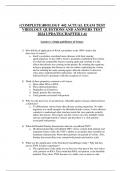
-
(COMPLETE)BIOLOGY 442 ACTUAL EXAM TEST VIROLOGY QUESTIONS AND ANSWERS TEST 2024 UPDATE(CHAPTER 1-6)
- Exam (elaborations) • 8 pages • 2024
-
- $11.99
- + learn more
COMPLETE)BIOLOGY 442 ACTUAL EXAM TEST VIROLOGY QUESTIONS AND ANSWERS TEST 2024 UPDATE(CHAPTER 1-6) Lecture 1: Origin and History of Viruses 1) How did the of application of Koch’s postulates in the 1880’s lead to the discovery of viruses? a. Koch’s postulates correlated many diseases with their causing agent/organism. In the 1880’s, Koch’s postulates established four criteria to isolate the responsible disease-causing agent and correlate it to the effects that disease was ca...
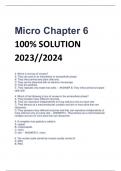
-
Micro Chapter 6 100% SOLUTION 2023//2024
- Exam (elaborations) • 7 pages • 2023
-
- $10.99
- + learn more
Micro Chapter 6 100% SOLUTION 2023//2024 3. Which is not true of viruses? A. They can exist in an intracellular or extracellular phase. B. They infect animal and plant cells only. C. They can be observed with an electron microscope. D. They are acellular. E. They replicate only inside host cells. - ANSWER B. They infect animal and plant cells only. 4. Which of the following is true of viruses in the extracellular phase? A. They possess many different enzymes. B. They can reproduc...

-
MICR 221 Exam Questions With 100% Correct Answers
- Exam (elaborations) • 26 pages • 2024
-
Available in package deal
-
- $9.49
- + learn more
MICR 221 Exam Questions With 100% Correct Answers AB toxins - Answer-They are two component protein complexes The A subunit has toxic (enzymatic) activity. B subunit binds to surface of host human cell and facilitates internalization of the A sub unit /.Adaptation of oral bacteria to challenging micro environments - Answer-early colonizers are exposed to a pH of 3-4 late in colonization, bacteria are present in an anoxic environment /.aerotolerant anaerobe - Answer-tolerate oxyge...

-
MIBO 3500 T3 QUESTIONS AND ANSWERS
- Exam (elaborations) • 11 pages • 2023
-
Available in package deal
-
- $14.49
- + learn more
Dimitri Ivanovsky Russian Botanist -- discovered disease was infectious (sap) Martinus Beijerinck Coined term "virus" to indicate non-bacterial Example of Viral Diseases Small Pox (Edward Jenner -- derived vaccine from cowpox) Poliovirus (causes poliomyelitis, paralysis, still exists all over the world mostly poorer nations ) What is hindering eradication of Polio -Cost of vaccine manufacturing -Inefficient supply -Limited vaccine available for supplementary immun...
![BMI3705- Comprehensive Virology Mastery Exam Elaboration Question and Answers [100% Correct] 2025 Latest Release!!](/docpics/6618658/6734674f9b674_6618658_121_171.jpeg)
-
BMI3705- Comprehensive Virology Mastery Exam Elaboration Question and Answers [100% Correct] 2025 Latest Release!!
- Exam (elaborations) • 23 pages • 2024
-
- $9.66
- + learn more
BMI3705- Comprehensive Virology Mastery Exam Elaboration Question and Answers [100% Correct] 2025 Latest Release!! Explain the primary differences between the lytic and lysogenic cycles of bacteriophages. The lytic cycle leads to the destruction of the host cell and immediate production of new virions, while the lysogenic cycle integrates the viral genome into the host DNA, lying dormant until activated. Describe how the structure of a non-enveloped virus enhances its stability o...
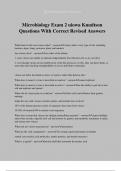
-
Microbiology Exam 2 uiowa Knudtson Questions With Correct Revised Answers
- Exam (elaborations) • 25 pages • 2024
-
- $12.49
- + learn more
Microbiology Exam 2 uiowa Knudtson Questions With Correct Revised Answers What kind of cells can viruses infect? - answerviruses infect every type of cell, including bacteria, algae, fungi, protozoa, plant, and animals Are viruses alive? - answertwo sides of the debate: 1. since viruses are unable to replicate independently from the host cell, so no, not alive 2. even though viruses do not exhibit most of the life processes of cells, they can direct them, so more than inert (lacking stren...
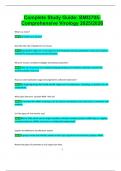
-
Complete Study Guide: BMI3705- Comprehensive Virology 2025/2026
- Exam (elaborations) • 29 pages • 2024
-
- $9.74
- + learn more
Complete Study Guide: BMI3705- Comprehensive Virology 2025/2026 What is a virion? Complete virus particle Describe the role of peplomers in viruses. Glycoprotein spikes on a viral capsid or viral envelope that bind specifically to host cell receptors, essential for host specificity and viral infectivity. Why are viruses considered obligate intracellular parasites? They do not possess the complex energy-generating and metabolic machinery required for survival outside...
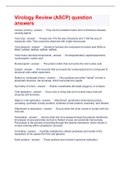
-
Virology Review (ASCP) question answers
- Exam (elaborations) • 14 pages • 2023
-
Available in package deal
-
- $18.19
- + learn more
Virology Review (ASCP) question answers Viruses (virions) They are the smallest known form of infectious disease-causing agents. Virus size Viruses are 1/10 the size of bacteria and 1/100 the size of eukaryotic cells. They cannot be observed with a light microscope. Virus genome Viruses of humans are composed of nucleic acid (DNA or RNA): ssDNA, dsDNA, ssRNA, dsRNA. Virion basic structure/components Enveloped/naked, capsid/capsomers, nucleocapsid, nucleic acid Nu...
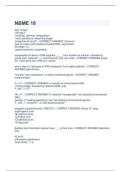
-
NBME 18 WITH 100% CORRECT ANSWERS
- Exam (elaborations) • 9 pages • 2024
- Available in package deal
-
- $9.99
- + learn more
2mo *infant* 102 deg F *vomiting, diarrhea, dehydration* *viral* particles w/ wheel like shape *properties of virus?* - CORRECT ANSWER *rotavirus* type of nucleic acid: double-stranded RNA, segmented envelope: no capsid symmetry: icosahedral transposition is when a DNA segment _____ from location to another, transferring genes from *plasmid* --> *chromosome* and vice verse - CORRECT ANSWER jumps (ex. vanA gene from VRE to S. aures) why is there a *decrease in VRE resistan...
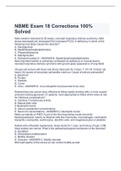
-
NBME Exam 18 Corrections 100% Solved
- Exam (elaborations) • 28 pages • 2023
- Available in package deal
-
- $12.49
- + learn more
Male newborn delivered at 28 weeks, neonatal respiratory distress syndrome, ABG shows decreased pH, decreased Po2 increased PCO2. A deficiency in which of the following most likely caused the disorder? A. Diacylglycerol B. Dipalmitoylphosphatidylcholine C. Phosphatidylserine D. Sphingomyelin E. Surfactant protein D - ANSWER-B. Dipalmitoylphosphatidylcholine Most important lecithin in pulmonary surfactant! so deficiency in it would lead to neonatal respiratory distress syndrome with gro...

Do you wonder why so many students wear nice clothes, have money to spare and enjoy tons of free time? Well, they sell on Stuvia! Imagine your study notes being downloaded a dozen times for $15 each. Every. Single. Day. Discover all about earning on Stuvia


